Backgammon
Starting The Game
With /join 2 players can join the game. With /start the game begins. Alternatively, you can use the Game Tool!
Object of the Game
The goal is to move your 15 stones around the board. You can start removing them once you have them all in your home zone. First to get all your stones home and then off the board wins. Be careful your stones don't get blocked in!
The Interface
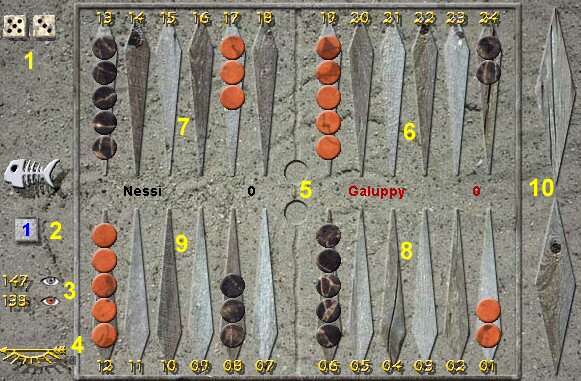
- Dice
- Doubling Die (Used in the Match Option)
- Points Left (Minimum total to roll to clear the board)
- Leave Room (Back Arrow)
- Bar
- Home Zone for RED (19-24)
- Outer Zone for RED (13-18)
- Home Zone for BLACK (01-06)
- Outer Zone for BLACK (07-12)
- Stack for removed stones
Backgammon is a game for two players, played on a board consisting of twenty-four narrow triangles called points. The triangles alternate in color and are grouped into four quadrants of six triangles each. The quadrants are referred to as a player's home board and outer board, and the opponent's home board and outer board. The home and outer boards are separated from each other by a ridge down the center of the board called the bar. The points are numbered for either player starting in that player's home board. The outermost point is the twenty-four point, which is also the opponent's one point. Each player has fifteen checkers of his own color. The initial arrangement of checkers is: two on each player's twenty-four point, five on each player's thirteen point, three on each player's eight point, and five on each player's six point.
Black and Red play in opposite directions:
- < b>Red will move in a clockwise direction, starting at 01 and moving off the board at 24.
- Black will move in a anti-clockwise direction, starting at 24 and moving off the board at 01.
Flow of the game
The players alternate by throwing dice and moving their stones across the board towards their home zone. You must first of all get ALL your stones into your home zone. Once you have done this, you can carry your stones off the board. The color of the fishes eye shows who is the current player. When it is your tune, click on the two dice
Stones always move in a circular fashion towards your home zone. A player moves by using the values shown on the dice. They can
a) from the 2 dice thrown, you move two different stones that value of each die
or
b) you move one stone the value of both dice added together.
You cannot just move the sum of the two dice. You must be able to move each die roll individually.
Example: You throw a 6 and a 3. You can
a) move 1 stone 6 points and 1 stone 3 points.
or
b) move 1 stone 6 points then 3 points (or 3 points then 6 points)
You can place as many stones as you want on any point.
Rolling Doubles
A player who rolls doubles plays the numbers shown on the dice twice. A roll of 6 and 6 means that the player has four sixes to use, and he may move any combination of checkers he feels appropriate to complete this requirement.
Example :You throw 2 #5s with the dice/em>
move 1 stone 5 points 4 times
or
move 1 stone 5 points 3 times and 1 stone 5 points
or
2 stones 5 points
or
move 4 stones 5 points each
Both Dice MUST be Used
There are many different options to play when moving your stones. You MUST however use both dice up.
Example: you throw a 6 and a 2.
The player cannot move a stone 2 points if he then cannot play the 6, if he could have played the 6 then the 2. If this is the case he must play the 6 first.
No Possible Play
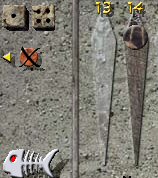
If a player cannot use all of the pips on the dice, then he must play what he can and then pass. To do so click on the crossed out stone located beneath the dice.
Additional Restrictions
If you cannot use one of the numbers from the dice, you must pass. If not you cannot use all 4 numbers from a double then you must also pass. You cannot move on to points which are occupied by > 1 opposition stone.
Being hit by a Stone
A point , which is occupied by a single stone, is called a Blot
If a player moves a stone on a Blot (lone stone) of the opponent, then it is " struck" and immediately placed on the bar.
Stones on the Bar
If a player has a stone on the bar, then he must play them first , before any other stones may be moved. Stones on the bar must always be played into the home run of the opponent: Black therefore would need to play to points 19 - 24 and red to points 01 - 06.
If you only have 1 stone on the "bar" and can place it on the board, you can use the other dice number to move any other stone of your color. All stones on the "bar" MUST be played first. If you cannot because your opponent is blocking your options in their home run then you must pass. You can only move your other stones which are on the board if there are NONE of your stones on the "bar".
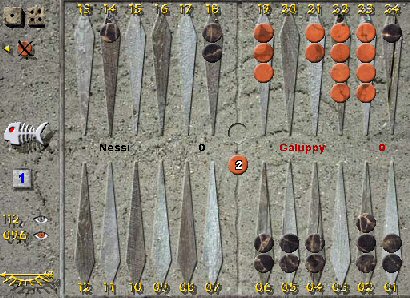
Example: Red rolls a 4 and a 1. Both points are occupied by black, red must pass threfore. If black had stones on the bar, he could play with 1 or 5.
When playing from the "Bar ", if your opponent has a "Blot", it too can be "struck".
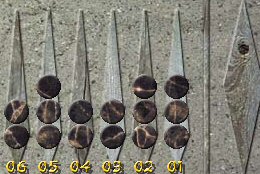
If a player blocked all six points of his home field, then is considered a shut out. The opponent must pass. The player with shut out continues play until a point becomes vacant or a "blot".
Home Plate
Once you get all of your 15 stones in your home run you can begin removing your stones to your home plate. You are only allowed to move your stones to home plate provided all your stones are on the home run and have NO stones on the "bar"! Once played out that stone is out of the game. A stone that is out-played does not return any more on the board. The home plate should be considered as 1 extra space when moving.
Example: Black has all his stones on the points within his home run. He rolls a 5 and 3. He can now remove one stone from point 5 and one from point 3.
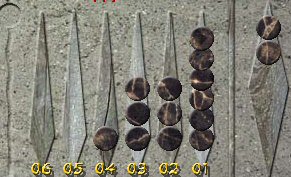
If a player throws a number, which is higher than the furthest the point is away from the home plate, he may move one stone from the further point away from the home plate.
Example: Black has already emptied points 5 and 6. Now if he throws a 5 or 6, he can remove the stone from point 4 off the board.
End of the Game
The play ends, as soon as the first player moves his last stone to the home plate. That player has won.
Game Options
match X
This option defines how many games in front of your opponent you need to win; i.e. play until one achieves or exceeds x games more than the other player.
This option also uses the doubling die into play. A win normally counts as one point. With the doubling die a player, on his turn, can offer a wager by clicking on the doubling die.
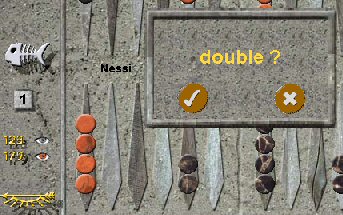
The opponent will then see this window appear. He can either accept the double, or rejects it, therefore losing the game (and the value of the game if previously doubled).
Example: A player decides to double for the first time. His opponent rejects the wager and therefore loses the game. If he decided to accept the wager then the value for winning the game is now worth 2 games (if the game is not re-doubled).
< span>The doubling can alternate and accumulate; i.e. black doubles then red re-doubles then black re-doubles again.
Gammon
If a player bears out all his stones, before his opponent can bear out one, this is called a Gammon and the winner receives double the points for the match.
Backgammon - Pending
If a player bears out all his stones, while his opponent has still has one of his stones either on the bar or in his opponents home run then this is called a Backgammon and the winner receives triple the points for the match.
Crawford Rule
If you are playing an n-point match and your opponent is ahead of you and he gets to n-1 points you are not allowed to use the doubling cube in the next game to come
tutor< /span>
This option places numbers on the points to help explain the game.

